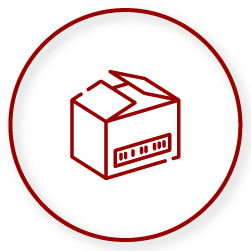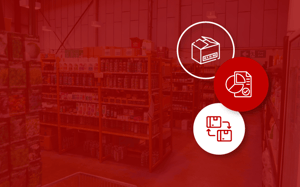Your product packaging can make or break your brand and reputation as a whole. Therefore, it is crucial to ensure that you implement the correct packaging and communicate it correctly to your customers and stores. Not only that, but it also has an impact on the shelf space you can give to it and other products.
If you have a product that takes up too much shelf space, how can you expect to meet your monthly sales targets? Or provide all of the products that your customers expect or want? That’s why you must be mindful when making any changes to your packaging.
About the contributors
Ilze Klopper joined DotActiv in 2018 as a shelf planner, working on the Amka account. Here, she is responsible for all the business analytics in all categories. Ilze is currently working on the development of Custom Reporting Templates within DotActiv Software.
Karike Pieters joined DotActiv in 2019 as a space planner for the Health and Pharmacy Department at Dis-Chem. Since then, she has changed roles to floor planner. She has a BSc Degree in Consumer Science from North-West University.
Nadia Cloete joined DotActiv in 2017 as a shelf planner, creating data-driven planograms for Makro, a wholesaler chain and subsidiary of Massmart that has international ties to Walmart. She currently works on the Makro General Merchandise account.
Michael Puckering joined DotActiv in 2017 as a space planner. Since then, he has worked on various accounts, gaining extensive experience across different retail environments. Currently, he is working on the ACDC account.

What is the relevance of changing your product packaging?
As a supplier or retail brand, you can change your product packaging for various reasons.
One example is the need to cut costs. Implementing more cost-effective packaging can mean less ink, a smaller container, different material and more. Changing the packaging so that it costs less can also mean that your cost price would be lower, which means you can lower your selling price, thus increasing your competitive advantage in the market.
The change in product packaging is also very relevant in the current business environment because of the eco-friendly trend. According to Recycling Today, customers who strive to be more sustainable, look at the packaging of products to see if it is recyclable or not. This factor could influence their buying decisions.
You can also update your product packaging to stay relevant with your customers and your brand. On the customer side, it's to continue evolving with current trends and preventing your items from being outdated and appearing old in the customer's mind. On the brand side, it is critical to update packaging so that it reflects your current brand image.
Availability of shelf space in-store is another reason for a change in the type or size of packaging. For example, a product previously hung on a hanging bar could be placed in smaller packaging on a shelf. This could also allow you to fit more products into the same shelf space.
Another reason for packaging changes is because of technological advances. As the retail environment and world adapt, so too must the packaging of your product. For example, a tube that would previously have leaked when pressed upon would, after a packaging change, have a “leak-proof” cap.
There is also the point that product packaging can negatively or positively impact its rate of sales. It all depends on how effectively you implement and communicate the packaging because it is essentially the first thing your customers notice about any product. As mentioned above, this is where up-to-date or appealing packaging plays a role - it can entice customers to pick it up off the shelf.
Meanwhile, poor or impractical packaging can turn your customers away. And there is nothing wrong with the product. By not improving the packaging, sales could decrease slowly until no one buys it.
A brand or supplier can change the packaging due to a change in the products’ UOM (unit of measure), which won’t necessarily mean that the visual aspect of the packaging will change, but rather just the technical aspects of it, for example, the dimensions or shape.
Of course, it’s critical to note that changing product packaging prematurely or too often can confuse your customers. It can also cause any brand-loyal customers to not recognise a product, which can lead to lost sales. It is thus crucial to ensure that any changes you make happen at once and that there are not two different packaging options on your shelf.
It is also important that the change in packaging is communicated to the customer so that they know that the product they purchased remains unchanged.

How does changing your product packaging impact your shelf space?
The impact product packaging changes have on your shelf space depends on each case. And you can look at the dimensions of each to explain this.
For example, if the products’ depth changes, it will impact the capacity and pack out of the products, either negatively or positively. If the products’ height or width changes from larger to smaller, it could impact the shelf space positively because you can give more facings to that specific product or another bestseller due to more space availability.
The worst-case scenario for a change in the height of the packaging is when it increases and a shelf needs to be removed from the gondola to accommodate the new dimensions of a products’ packaging. Taking into account the weight of the product, you can move it to a top-shelf to prevent losing a shelf.
If the product packaging increases in width, it could cause your whole range to not fit on the shelf or designated area. This could mean that your quantities on the shelf might have to be relooked or it would be merchandised as a ‘snake’. This is where you’d move a product or a few products to the shelf below or next to it.
Doing this could also affect any other brands on your shelf, which could negatively impact your relationship with your suppliers if not communicated correctly. The impact that a product's packaging change can have on other products can be determined by a thorough category management analysis.

How can you use reporting to determine the impact on your business?
You can use reporting as a forecasting tool to determine the overall performance of your new packaging and how customers will react to it.
The first thing to consider and determine is whether you intend to let the old packaging sell out first or introduce the new packaging gradually and mix it in with the old packaging on the shelf. The latter is not the ideal solution, but you might not have a choice or the ability to correctly market the change.
You can also use reporting to compare the impact of the change in terms of how many products would fit in a certain area on the shelf compared to the original packaging.
Reporting can aid in understanding your return on investment.
For example, if your percentage of units sold is higher than the percentage of sales achieved, it means that you have a cheaper product. Ultimately, cost-effectiveness appeals to the customer. Thus you need to ensure that your budget for the change in packaging doesn't exceed the return on investment.
If your packaging becomes more expensive, the price of the product will have to increase. Would the customer accept this or move to a cheaper product? On the other hand, if you make more sales by moving fewer units, it means your product is slightly more expensive and could indicate that the target customer is more brand loyal and would likely stick with the brand even if there is a slight price increase.
If packaging becomes more expensive, the cost would need to be absorbed somewhere. Either by the supplier in terms of a reduced profit margin or by the consumer at a higher retail selling price.
You can also determine the impacts by doing a pre and post-analysis. This will be executed by taking a critical look at your data pre-implementation and comparing it to the data 3 to 6 months after implementation.
By using DotActiv custom reporting, you can analyse the impact by running reports related to space allocations. With these, you can use a planogram from before the packaging changed and a new planogram from after the packaging changed.
You can also use a report, which shows the comparison between the previous packaging and new packaging (highlights, flows, performance graphs and so on). A performance analysis report will also be handy as it analyses how the data performs if you only focus on the new packaging lines, where you have pre-analysis data (3 to 6 months data before packaging changes) vs post-analysis (3 to 6 months data after packaging changes). This can also be achieved with custom reporting.
Through custom reports, you can track whether the new product packaging grew the category or if it harmed the category. Also, you can track shopper behaviour. Will they still be brand loyal or will they turn to another product after a change in packaging?
You can also generate reports to help you analyse your floor space. When looking at a bigger product such as braais; furniture or plants, the floor space should be taken into account and analysed on the same basic principles of shelf planning.
You can complete a category analysis at a departmental level when discussing macro space. Furthermore, you can use ‘heat mapping’ within DotActiv software. This uses the days of supply (DOS) highlight function to see if a product is in a highly congested area of your store.
Conclusion
Your shelf space is invaluable and you need to take good care of it so that you can maximise it. If you need to change your product packaging or stock products that have new packaging, it's critical to understand its impact on your shelf space.
Do you need help planning or understanding your shelf space? You can book a complimentary custom exploratory consultation with us here or visit our online store.


